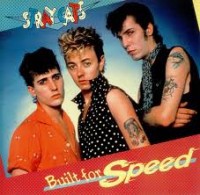Nostalgia Is Not New

“Are 18- to 34-year-olds too young to be nostalgic? Evidently not. Starting next Monday, TeenNick, part of the Nickelodeon family of cable channels for children, will start rebroadcasting old series from the 1990s that are considered classics by young adults. That’s right: classics from the 1990s.”
I am surprised that the New York Times finds this surprising. My sophomore year of college, 1991, this guy I knew threw an ’80s Party. Where people dressed up in ’80s fashions and danced to ’80s music. The early ’80s held sway, apparently: pastel leg-warmers and off-the-shoulder Flashdance sweatshirts, Flock of Seagulls and Frankie Goes to Hollywood. I didn’t go to the party, because it just seemed too ridiculous. I was still wearing plenty of clothes I wore in the ’80s in 1991.
I was surprised, then, at the speed at which we’d cycled from first-round appreciation to a kitschier, nostalgic appreciation. But the party proved very popular. There were more of them. And more of them. By the time I graduated, in the mid-’90s, the ’80s Party had become a staple of young doofus nightlife not only at my college, but all across the country. I moved to New York and a nightclub devoted to the phenomena opened there soon after. It was called Culture Club, like the iconic ’80s band, and the Cs were written like Pacman, the iconic ’80s video game. There was a promotional van that used to drive around the city. It was annoying. But even at that point, not surprising. There was lots of stuff written about Generation X — which I think is my generation, if I understand it right — and how we were so quick so nostalgify everything. All those t-shirts with ’70s and ’80s brand logos. “Sunkist,” “Bubblicious,” etc. I used to wear velour shirts (I cringe a little at the thought) like Steven Malkmus from Pavement did, imagining that I was achieving a sort of tongue-in-cheek “grooviness.” But I felt like I came by it honestly, since I’d worn velour shirts as a kid in the ‘70s.
But the line between kitsch and anything else is a blurry one. The movie the The Wedding Singer came out in 1998, making much of its temporal setting in 1985. Less than ten years later, you could see the fashions at which it poked fun everyday on the street. I was surprised then by this stuff. It’s probably natural, as we get older, to feel like, “Wow, that style is back? Already?” But I shouldn’t have been. I can remember sitting and watching TV in the mid-’70s, weekdays, at my babysitter Peg Linville’s house, her son Tommy and I. We loved “Happy Days,” which was set in the ’50s. It used to come on right after “The Lone Ranger,” reruns, which were made in ’50s. I was probably wearing a velour shirt.
